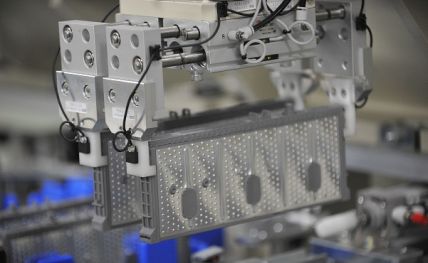|
|
Sci-Tech
Japan Pushes into Advanced Battery Field
Monday, August 9, 2010
 Advanced Battery
Advanced Battery
By Roger Schreffler
The biggest names in Japanese industry, from Panasonic and NEC to Toyota and Mitsubishi, are investing billions of dollars into battery-related research - in part because they should in the face of global warming, and in part because they must as low cost petroleum reserves are declining.
Japan's Natural Resources and Energy Agency has warned that, left unchecked, the world would likely witness a 60% increase in energy demand over the next twenty years, from 2005 levels, with the largest amount of growth coming from China, which, according to the agency, will account for 25% of global consumption, up from 15% in 2005.
A senior executive at Panasonic, which together with auto giant Toyota Motor has been making batteries for "hybrid" electric cars since the late 1990s, predicts that within the next ten years rechargeable battery demand will grow 2.5 times from US$22 billion in 2009 to US$52 billion in 2018.
Panasonic estimates for 2012 and 2015 are US$31 billion and US$44 billion respectively.
Panasonic, which acquired rival electronics maker Sanyo Electric last December, is especially bullish on lithium-ion batteries and predicts fivefold growth from US$6 billion in 2009 to US$32 billion in 2018.
Of the 2018 total, nearly 60%, or US$18.9 billion, will be for clean vehicles, including both hybrids and pure electric vehicles.
Japan's hope, according to the Natural Resources and Energy Agency, is to become a leader in "clean" energy technology.
In April, Panasonic began lithium battery cell production at a new plant in suburban Osaka. The plant will feature integrated production from electrodes to battery cells. Capacity is 300 million cells per year.
Meanwhile, Panasonic began mass-producing a 3.1-Ah lithium battery last year that boasts specific energy and energy density of 11.2 Wh and 675 Wh/L. The battery employs a cobalt-type positive electrode and carbon-type negative electrode.
In 2012, the manufacturer plans to switch to "advanced" nickel and silicon for the positive and negative electrodes, in the process boosting specific energy and energy density to 13.6 Wh and 800 Wh/L.
Roger Schreffler is a veteran business journalist who has covered the Japanese energy scene for more than twenty years.
PanOrient News
© PanOrient News All Rights Reserved.
|
|